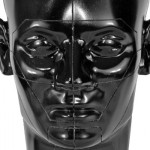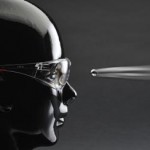Most people wouldn’t dream of mowing the lawn barefoot but don’t hesitate weed whacking without protective eyewear. Eye injuries from debris and rocks thrown by household tools like lawn mowers, chain saws and weed trimmers occur daily.
In California, OSHA regulations and enforcement of personal protective equipment have reduced the number of injuries in the workplace. Most eye injuries now happen at home.
What makes safety glasses safe?
 Safety frames must pass two rigorous impact tests, which dress frames do not undergo, to be marked Z87 (the ANSI, American National Standards Institute, requirement). A special device call an Alderson Head Form, which simulates a physical human head is used.
Safety frames must pass two rigorous impact tests, which dress frames do not undergo, to be marked Z87 (the ANSI, American National Standards Institute, requirement). A special device call an Alderson Head Form, which simulates a physical human head is used.
The High Velocity Impact Test
A 1/4″ steel ball traveling at 150 feet per second is directed at different designated positions on the front and side of a frame glazed with plano  lenses. No contact with the eye or head form is permitted as a result of the impact, nor shall any parts or fragment be ejected from the protector that could contact an eye of the head form.
lenses. No contact with the eye or head form is permitted as a result of the impact, nor shall any parts or fragment be ejected from the protector that could contact an eye of the head form.
The High Mass Impact Test
A pointed projectile weighing 17.6 ounces is dropped from a height of 51.2″ on a glazed frame. No parts or fragments shall be ejected from the protector that could contact an eye of the head form.
Prescription Safety Frames
If you need correction to see, safety frames can be made with prescription lenses that meet ANSI. The lenses and frame will have Z87 on them. The lenses must pass a drop ball test. (A 1″ steel ball is dropped on the lens from 50″ high.)
Please note that safety glasses and sports glasses are not interchangeable. Sport glasses do not need to pass ANSI tests and safety glasses are not appropriate for sports applications.
Below is a chart providing guidance for the proper selection of eye and face protection for particular risks.
Westside Optometry has different styles of ANSI approved safety glasses to make in prescription. We offer safety frames in plastic and metal materials with side shield options.
| Hazard Assessment | ||
| Hazard type | Examples of Hazard | Common Related Tasks |
| Impact | Flying objects such as large chips, fragments, particles, sand, and dirt. | Chipping, grinding, machining, masonry work, wood working, sawing, drilling, chiseling, powered fastening, riveting, and sanding. |
| Heat | Anything emitting extreme heat. | Furnace operations, pouring, casting, hot dipping, and welding. |
| Chemicals | Splash, fumes, vapors, and irritating mists. | Acid and chemical handling, degreasing, plating, and working with blood. |
| Dust | Harmful Dust. | Woodworking, buffing, and general dusty conditions. |
| OpticalRadiation | Radiant energy, glare, and intense light | Welding, torch-cutting, brazing, soldering, and laser work. |
One thought to “Safety Glasses”